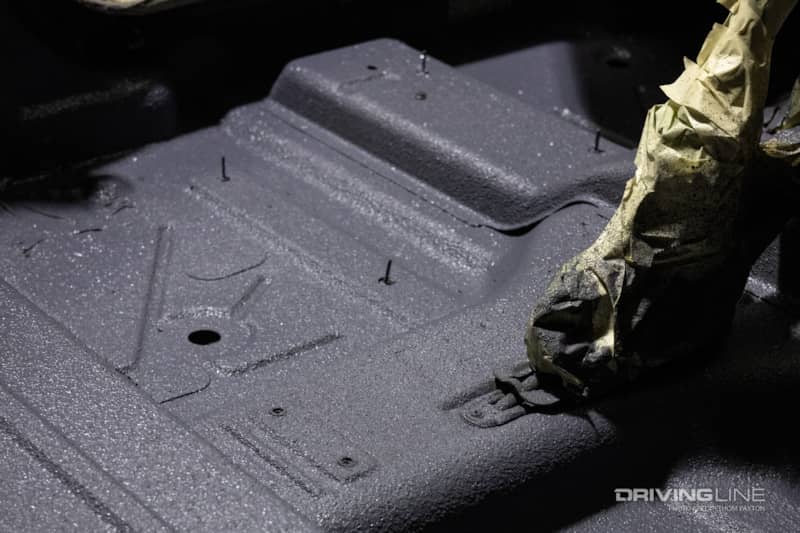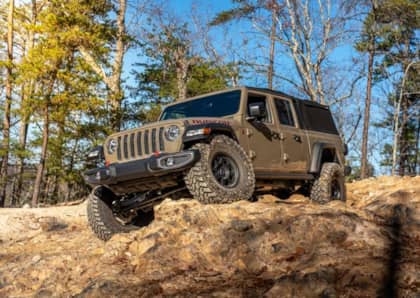How to Reduce Noise and Heat Transfer into the Cabin of an LS V8-Swapped Jeep
Our 2005 Jeep LJ (affectionally known as the Samuel LJ) features a 6.2L LS V8 power plant and a 6L80 transmission. Producing 420hp, the combo provides plenty of power to offset the 40” Nitto Trail Grapplers and Miller Motorsports SpiderTrax axle housings found under the Jeep. But it also provides its fair share of heat. So much so, that the cab of our Wrangler Unlimited becomes uncomfortable when sustaining highway speeds or during a long day of crawling on the trail. In addition to excessive heat, our fire breathing LS motor is far from quiet. Luckily for us, we found a solution that addresses both of those issues.

LizardSkin Automotive Insulation
After doing our due diligence in online research, we found LizardSkin cab insulation that should reduce cabin noise and heat transfer into the cabin produced by the V8, transmission and transfer case. Mostly notably recognized amongst the hot rod crowd, LizardSkin provides spray-on noise and heat insulation for automotive applications. They offer three different products – Ceramic Insulation, Sound Control, and TopCoat. The Ceramic Insulation is designed to reduce engine and solar heat transfer, while the Sound Control reduces and deadens sound and noise transfer. The TopCoat doesn’t offer any of these properties previously mentioned, but does add durability, traction, and a nice glossy appearance when used on top of the other coatings. When applied to a properly prepared surface, it also creates a seamless membrane that provides constant protection against moisture, eliminating the ability for rust to form.

Bed Liner vs. LizardSkin
Before landing on LizardSkin, we initially looked at doing a RhinoLinings coating. Our good friends at 3D Off-Road own the RhinoLinings business in our local town of Colorado Springs, and do a fantastic job at installation. Having it done right would be no issue, in fact we applied RhinoLinings to the tub of the Silver Bullet LJ with the help of Matt Thompson’s team at 3D and the end result was spot on. But there’s a difference in the two products, and in the two LJs as well.

RhinoLinings is harder and more durable, but doesn’t carry the same heat reduction and sound deadening properties as LizardSkin. The Silver Bullet LJ has the factory 4.0L V6 motor intact, which doesn’t produce nearly as much heat as the 6.2L LS V8 in the Samuel LJ. The tub inside of Silver Bullet had some rust and other damage, so the primary goal was to put a heavy duty, durable coating down that would protect it from any further damage. However, on the Samuel LJ, we don’t need the durability of RhinoLinings since the factory carpet is going back in. It is for those reasons that LizardSkin felt like the right application for this particular Jeep.

Sound Control & Ceramic Heat Insulation
We decided to opt for both the Sound Control & Ceramic Heat coatings for this project, since the two combined seem to check all the boxes. We did however opt out of the TopCoat since the factory carpet is going back in. LizardSkin recommends applying the Sound Control coating first, followed by the Ceramic Heat. The process is rather straight forward, and with 3D Off-Road’s experience in spray-on coatings, we turned to them to help us with the install.

Preparation is Key
As with most things, the prep is the most important step to the coating process. Making sure the vehicle is taped off with protective wrapping to eliminate overspray is step one. Step two is to scuff the surface of the tub (factory paint) and ensure that the surface being sprayed is clean, dry, and free of rust, oil, and grease so that the LizardSkin has a solid surface to bind to. It’s important to note that the ambient/substrate temperature must be above 60 Deg F. Once prep is complete, you’re ready to spray.

Spray-On Installation
Now that the Samuel LJ has gone through the rigorous preparation phase, we’re ready to begin spraying on the Sound Control. LizardSkin provides a mil gauge, and states that the optimal wet film thickness is 40 mils for each product. They recommend achieving this spec by spraying two 20 mil coats for each product. We used LizardSkin’s SuperPro Application Kit which provides a a sprayer and 1-quart cup to hold product, as well a stir paddle and wet mil gauge. We wanted to make sure that we applied each coating to their exact specifications so that we could get the full effect. We let the vehicle sit for about 3-4 hours between the two coats of Sound Control, and another 36 hours after before applying the Ceramic Heat. We applied both coats of Ceramic Heat in the same fashion, with about 3-4 hours between coats. Once complete, we let the Jeep sit for about 48 hours before removing the tape and wrapping, and then began reinstallation of our roll cage, carpet and seats.

Overall Impressions
The install went straight forward thanks to 3D Off-Road’s expertise. The hardest part was prepping the vehicle, which happens to take the longest as well.

Now that both the Sound Control and Ceramic Heat Insulation were applied, it was time to go for a drive and see if there was any noticeable difference. We went into this with little expectations and were pleasantly surprised by how much of a difference the Lizard Skin made. The sound inside the cab is noticeably quieter, with the biggest difference being the significant reduction in heat coming in from the 6.2L LS V8 & 6L80 transmission. Admittedly, we were less concerned about sound than we were about heat. At times it is fun to hear the V8 rawr, but given the reduction in heat inside the cab, the Samuel LJ is already so much more comfortable to drive.

Be sure to keep an eye out for a video on the Built2Wander Vlog Series hosted by Driving Line where we dive into these improvements and further show what a difference LizardSkin has made in a future episode.







